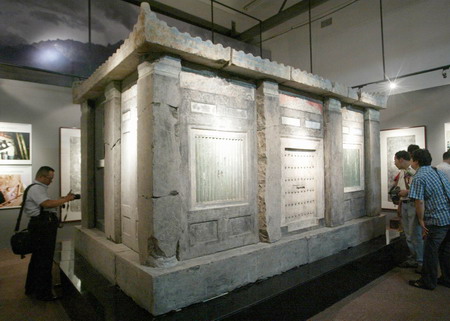Society
Tang Dynasty sarcophagus brought back home
By Ma Lie and Lin Shujuan (China Daily)
Updated: 2010-06-18 07:03
 |
Large Medium Small |
|
 The sarcophagus of Tang empress Wu Huifei (AD 699-737) is displayed in Xi’an, Shaanxi province, on Thursday, June 17, 2010. [China Daily] |
XI'AN - The return of a smuggled Tang Dynasty (AD 618 - 907) sarcophagus from the United States to China may serve as a good example for international collaboration to curb the rampant pillaging and smuggling of treasures, researchers have said.
| ||||
The sarcophagus is 4 meters long, 2 meters wide and 2 meters high. It features flowers and maiden figures in relief. Robbers stole it from Wu's tomb in the southern suburbs of Xi'an, capital of Shaanxi province, in 2006.
"It is a rare cultural relic with high scientific, historical and artistic value," said Liu Daiyun, director of the research department of the Shaanxi provincial archaeological research institute.
Xi'an police found out about the sarcophagus in February 2006 during an investigation over a tomb robbery. They seized a computer containing a number of its pictures in a suspect's house and local archaeologists soon identified the relic's origin.
After two years of investigations, police discovered the sarcophagus had been smuggled out of China and sold to a businessman in the US for $1 million, police sources said.
"We contacted the businessman through mediators and told him we had to get the relic back. If necessary, we would seek help from Interpol," said Han Yulin, head officer of the heritage investigation team of Xi'an's public security bureau.
"After three rounds of negotiations, he agreed to return the relic to China unconditionally."
The sarcophagus was shipped back on March 16 from Virginia and arrived in Guangzhou, capital of Guangdong province, on April 17.
"Although this is not the first time smuggled antiques have been returned through legal means, it is still encouraging," said Tan Ping, head of the museum and cultural relics department of the State Administration of Cultural Heritage (SACH).
The pillaging of Chinese antiques is a serious problem in China. Chinese art analysts have blamed a thriving global market for the relics as the reason behind widespread tomb robberies.
"Pillaging at archaeological sites and smuggling of relics have become rampant in recent years," SACH deputy director Tong Mingkang said last Saturday, which was China's Cultural Heritage Day.
Driven by high profits, a number of people have put numerous looted and smuggled Chinese artifacts on sale in foreign countries, Tong said.
Foreign museums have a collection of about "1.64 million Chinese relics", Tan said, adding that it was impossible to provide an exact figure for those relics in the hands of private collectors.
SACH has reiterated its objection to any auction or purchase of smuggled Chinese cultural relics.
Tan said China continues to seek the return of its looted relics through "legal or diplomatic means".
To that effect, the country has reached agreements with 11 countries including Peru, India, Italy and the US to impose import restrictions on relics.
These restrictions will reduce the economic incentive behind the pillaging, said Professor Li Boqian, an archaeologist at Peking University.
"If looters cannot send the items to buyers in the United States or other foreign countries, they are less likely to risk raiding an archaeological site," Li said.
The professor also stressed the importance of local police efforts in fighting the problem.
"Xi'an police set a good example by keeping a close eye on the looting of antiques," Li said.
China has retrieved nearly 4,000 antiques through legal and diplomatic means since 1998, SACH archives showed.



